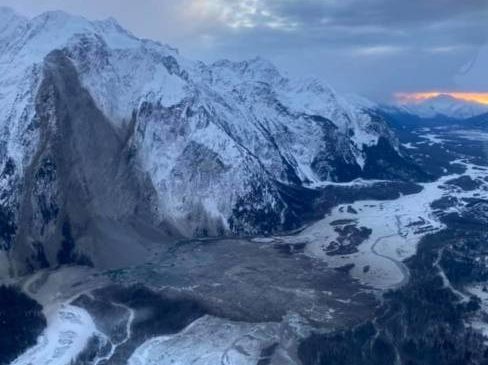
Around Christmas, there were reports of an earthquake and major mountain rockslide in the wilderness near Juneau. But what came first: The earthquake or the slide?
Jamie Tait is a helicopter pilot based out of Atlin, British Columbia. The day after Christmas, he and his family were flying along the Taku River valley after checking on a cabin in the area.
“It’s pretty interesting because I’ve flown down that river for probably the better part of 35 years,” Tait said. “I noticed it right away, before the rest of my family did, and it’s pretty significant.”
About 46 miles northeast of Juneau, one mountain along the river looked as if part of its face had been sliced off.
“The area in the valley was all full of the debris and mud that had been pushed up when the mountainside collapsed,” Tait said.
Sonia Nagorski, assistant professor of geology at the University of Alaska Southeast, said some of the area’s mountain slopes are over 50 degrees. In other words, the slopes are so steep they’re almost like a cliff face.
“And so, it just crumbles and fails,” Nagorski said. “It’s pretty astounding that those rocks are sitting at the steep angle at all.”
Nagorski said there’s a lot of volcanic rock in the area, which used to be under the earth’s surface, and isn’t as strong as other forms of rock. It’s more susceptible to weathering under rain, snow, ice, and lots of freezing and thawing.
“It’s easy to think that our mountains are solid and stable, but the Earth’s surface is constantly shifting, especially when there are tectonic changes and glacial changes,” Nagorski said.
“A lot of the changes can be quite sudden. And land sliding is the primary method of erosion in mountains steeper than about 30 to 40 degrees, which are plentiful here.”
Nagorski said it’s not clear exactly how much of the nearly 4,000-foot mountain actually flaked off and fell away at 10:50 a.m. on Christmas Eve. Her best estimate is 20 million cubic feet of material, or enough to fill up half of the Houston Astrodome.
When all that rock fell, it was enough to literally shake the earth. Natalia Ruppert, a seismologist with the Alaska Earthquake Center, said if the shaking was caused by an earthquake, it would’ve registered as a magnitude 2.8 or 2.9.
Ruppert is clear, however: The landslide was not triggered by an earthquake. It’s easy for seismologists to distinguish the sudden, abrupt start of an earthquake from a landslide’s gradual building of intensity, sometimes over several minutes.
“It starts very small, and then gradually the amplitude of the signal picks up and then becomes larger and larger as the landslide mass kind of gains momentum and moves down the slope,” Ruppert said. “And then it plays out as all those rocks come to a final resting place.”
Ruppert said this wasn’t the first, or even the biggest event in the area: Bigger landslides were detected around Southeast Alaska in 2005 and 2008.
“And then, in subsequent years, some of them are much, much larger than this landslide on the Taku River,” she said. “Some of those were so large that they were detected even globally.”
The Taku River is one of biggest salmon producing rivers in Southeast Alaska. Since it crosses an international boundary, both United States and Canada share its harvest.
David Harris, commercial fisheries area management biologist with the Alaska Department of Fish and Game, said the slide likely destroyed any salmon roe at the foot of the mountain. But he believes it won’t have a big impact on salmon runs overall.
“The channel is fairly braided,” Harris said. “There’s two or three large channels already, plus smaller connecting side sloughs and whatnot. There’s plenty of room for the water to find a way through. It’s not like a narrow valley that’s filled up with material.”
Harris said much bigger landslides have completely blocked the Taku in the past, but the river always finds a way to cut through them.
Pilot Jamie Tait warns Alaskans who have cabins or recreate along the Taku to watch out for uprooted and dead trees washing downriver in the spring.
Matt Miller is a reporter at KTOO in Juneau.




